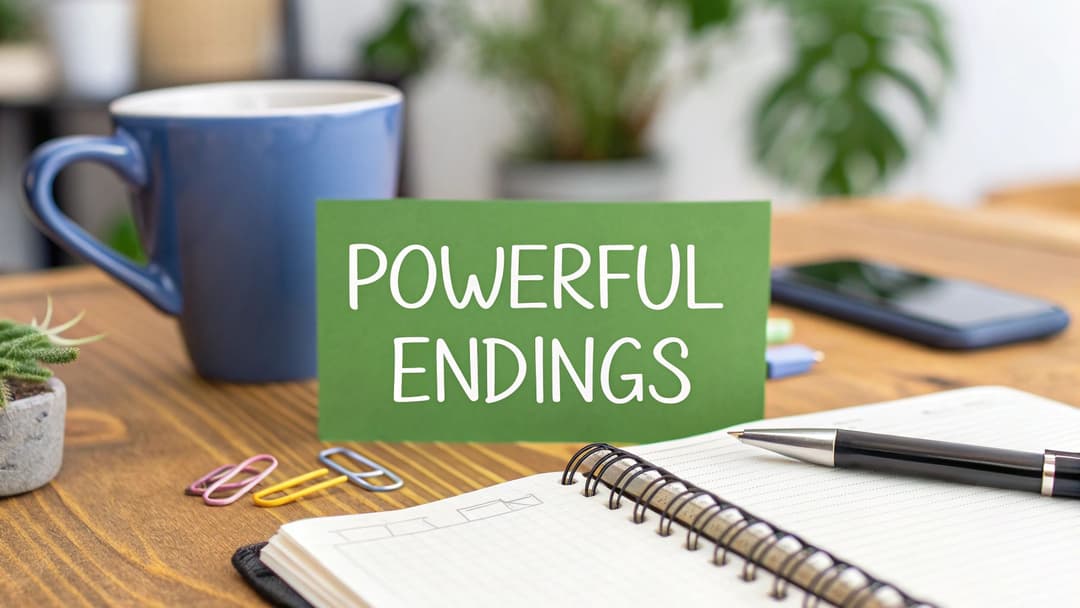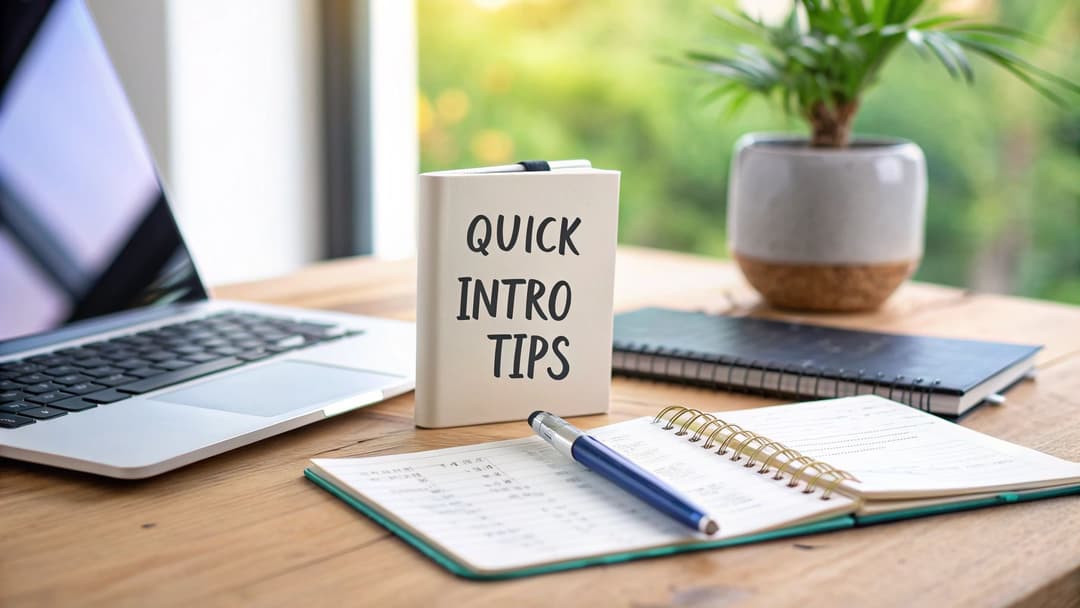
How to write a personal statement that wins admissions
November 20, 2025
Here’s the deal: writing a personal statement comes down to four things. You need to reflect on a core experience, tell it like a story, write in your own voice, and polish it until it’s perfect. This essay is your one real shot to show the admissions committee who you are beyond the numbers. It’s how you turn your journey into a narrative that actually connects with a real person on the other side.
Your Game Plan for a Winning Personal Statement

The personal statement can feel like the scariest part of the whole application. It's just a 650-word essay, but it feels like everything is riding on it. You’re being asked to distill your entire life, personality, and dreams into a single, short story.
But here’s the thing—unlike your GPA or test scores, this is the one part of the application you have total control over. It's your space to give context to the rest of your file, show off your personality, and explain the "why" behind what you want to do.
Admissions officers read thousands of these things. They aren't just looking for good writing. They're trying to build a class full of interesting, diverse people. Your statement helps them see past the data and understand how you think, what gets you out of bed in the morning, and what you’d bring to their campus.
What Makes a Personal Statement Stand Out
A truly memorable essay does more than just list your accomplishments. It weaves a thread from your past experiences to your future goals, creating a focused and reflective story. The best essays aren’t trying to sound smart with big words or dramatic, unbelievable stories. Their power comes from genuine honesty and a bit of introspection.
The personal statement isn’t about impressing someone in an office—it’s about inviting them into your story. When written with honesty and care, it can show the values, motivations, and dreams that GPAs and scores can’t capture.
To pull this off, your essay needs a clear purpose. You need a game plan before you even think about writing. This guide is your blueprint, breaking down the process into four essential pillars that will help you turn that intimidating blank page into a statement that sounds exactly like you.
The Four Pillars of a Strong Personal Statement
Think of these four elements as the foundation for your entire essay. If you can nail each one, you’ll end up with a draft that’s focused, compelling, and genuinely authentic.
Here’s a quick breakdown of what to focus on.
| Pillar | What It Means | Why It Matters |
|---|---|---|
| Authentic Storytelling | Choosing a theme or experience that is genuinely meaningful to you—not what you think they want to hear. | Authenticity is something you can feel. A real story connects emotionally and makes your application far more memorable than a generic one. |
| Clear Structure | Organizing your story with a great hook, a logical body that shows your growth, and a conclusion that sticks with the reader. | A strong structure acts like a roadmap for the reader, making sure your message is clear and powerful from the first sentence to the last. |
| Vivid Detail | Using specific anecdotes, sensory language, and concrete examples to "show" your story instead of just "telling" it. | Details are what make your experiences feel real. They make your essay engaging and prove the claims you’re making about yourself. |
| Meticulous Polish | Thoroughly revising, editing, and proofreading your draft to kill any errors and sharpen your voice. | A polished essay shows you’re professional, you care about the details, and you respect the person reading your application. |
Get these four pillars right, and you'll be in a fantastic position to write an essay that not only gets you noticed but truly represents who you are.
Finding Your Core Story Before You Write
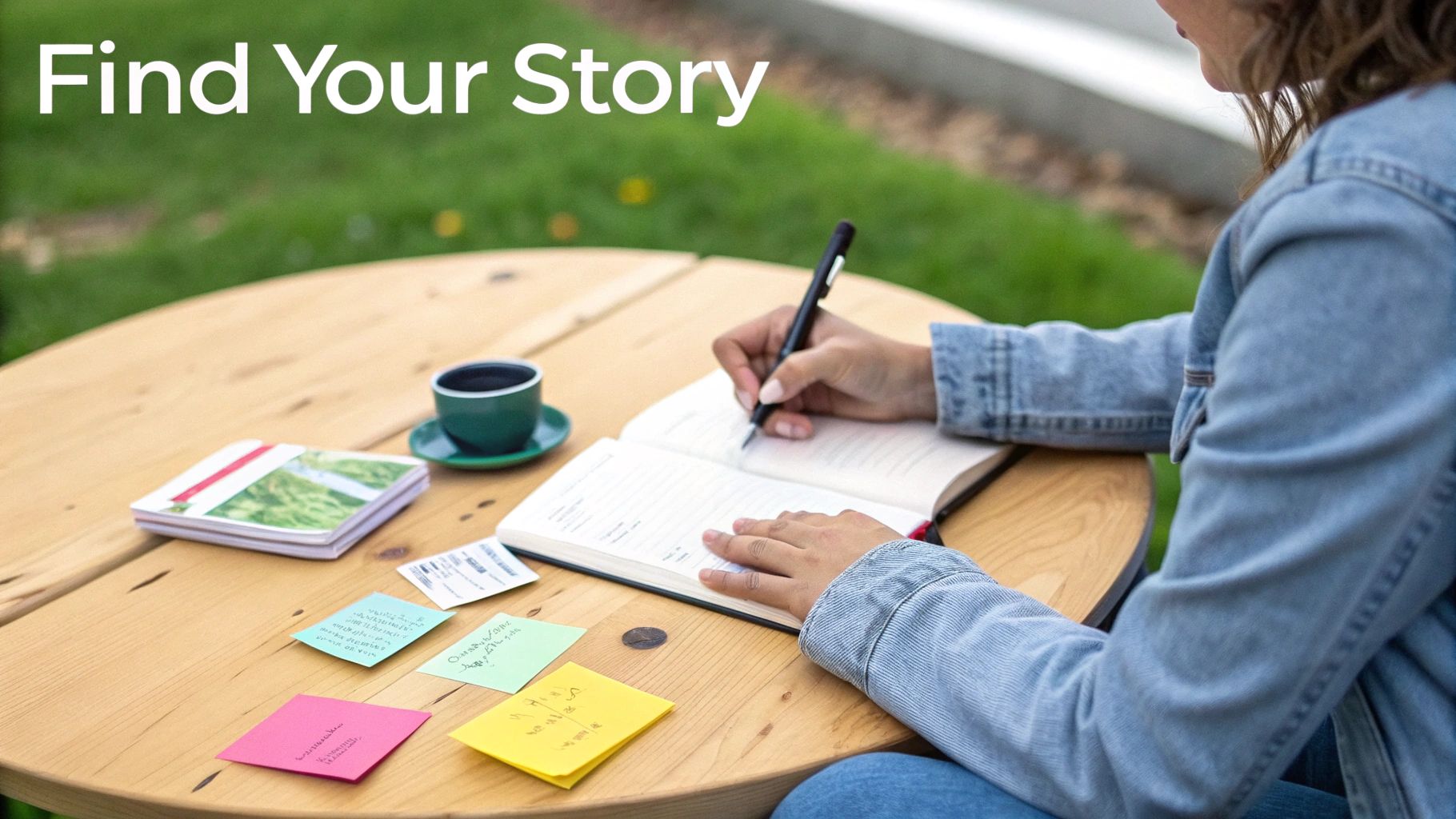
Before you write a single word, you need to figure out what you’re actually going to write about. This isn’t about picking the most dramatic moment of your life or trying to sound impressive. It’s about digging deep to find a genuine story that reveals who you are. The best personal statements are built on self-discovery, not a checklist of accomplishments.
Your real goal here is to find a central theme—a core story—that ties your past experiences to your future ambitions. This is the foundation. Without it, an essay can feel like a scattered list of facts that never quite comes together. A strong narrative thread is what separates a forgettable application from one that feels focused, powerful, and deeply personal.
The truth is, many essays fail because they lack focus, not because the applicant lacks good stories. Research has found that a shocking 70% of personal statements are too broad. They try to cram everything in, and as a result, nothing truly resonates. The most successful essays do the opposite: they connect a few key experiences to create one cohesive, compelling narrative.
Uncovering Your Defining Moments
The first step is simple reflection. Forget the prompts for a minute and just think. What moments have actually defined you? Don't censor yourself or worry if an idea is "good enough" yet. Just let the ideas flow.
Grab a notebook or a blank doc and spend some time with these questions. Write down whatever comes to mind—no judgment.
- Think about a challenge: When did you face a serious obstacle or even fail at something? What did you do? More importantly, what did that experience teach you about yourself?
- Identify a moment of growth: Can you pinpoint a time when your entire perspective on something shifted? What triggered that change in your thinking?
- Recall a spark of curiosity: What’s a topic or idea you find so fascinating you can lose track of time thinking about it? What is it about that subject that completely captivates you?
- Reflect on your background: How has your identity, community, or upbringing shaped the person you are today? Think about traditions, values, or unique experiences you’ve had.
You're not looking for one perfect answer here. You're just generating raw material. These memories are the building blocks for your core story.
Connecting the Dots to Find Your Theme
Okay, now you have a list of moments. The next job is to search for a common thread. A great personal statement isn't just a cool anecdote; it’s an anecdote that explains why you're applying to this specific program.
Look over your brainstormed list and ask yourself:
- Which of these stories best explains my motivation for this field?
- Does this experience show a key quality (like resilience, curiosity, or leadership) that makes me a good fit?
- How does this moment connect to my long-term goals?
For example, a story about building a computer from scratch isn't just about technical skill. It could be your core story about a deep-seated love for problem-solving or a fascination with complex systems. That theme is so much more powerful than just saying, "I am good with computers."
Your core story is the "why" behind your application. It’s the narrative that gives meaning to the facts on your resume, transforming a list of achievements into a purposeful journey.
A huge part of writing a winning statement is learning how to tell your story effectively. Once you find your theme, it becomes your north star, guiding every paragraph and keeping the entire essay cohesive.
From Broad Ideas to a Focused Narrative
Now, take your strongest idea and start mapping it out. Don't stress about perfect sentences yet. Just focus on the story's arc. Every good story has a beginning, a middle, and an end.
Here’s a simple way to structure your thoughts:
- The Situation: Set the scene. What was the initial context?
- The Catalyst: What happened? Describe the challenge, discovery, or turning point.
- The Action & Insight: What did you do, think, or feel? This is where you show reflection and growth.
- The Outcome & Future: How did this experience change you, and how does it connect to what you want to do next?
This framework helps you move from a vague memory to a structured narrative with a clear point. It ensures your story is a powerful demonstration of your character, not just a recap of events.
Structuring Your Narrative for Maximum Impact
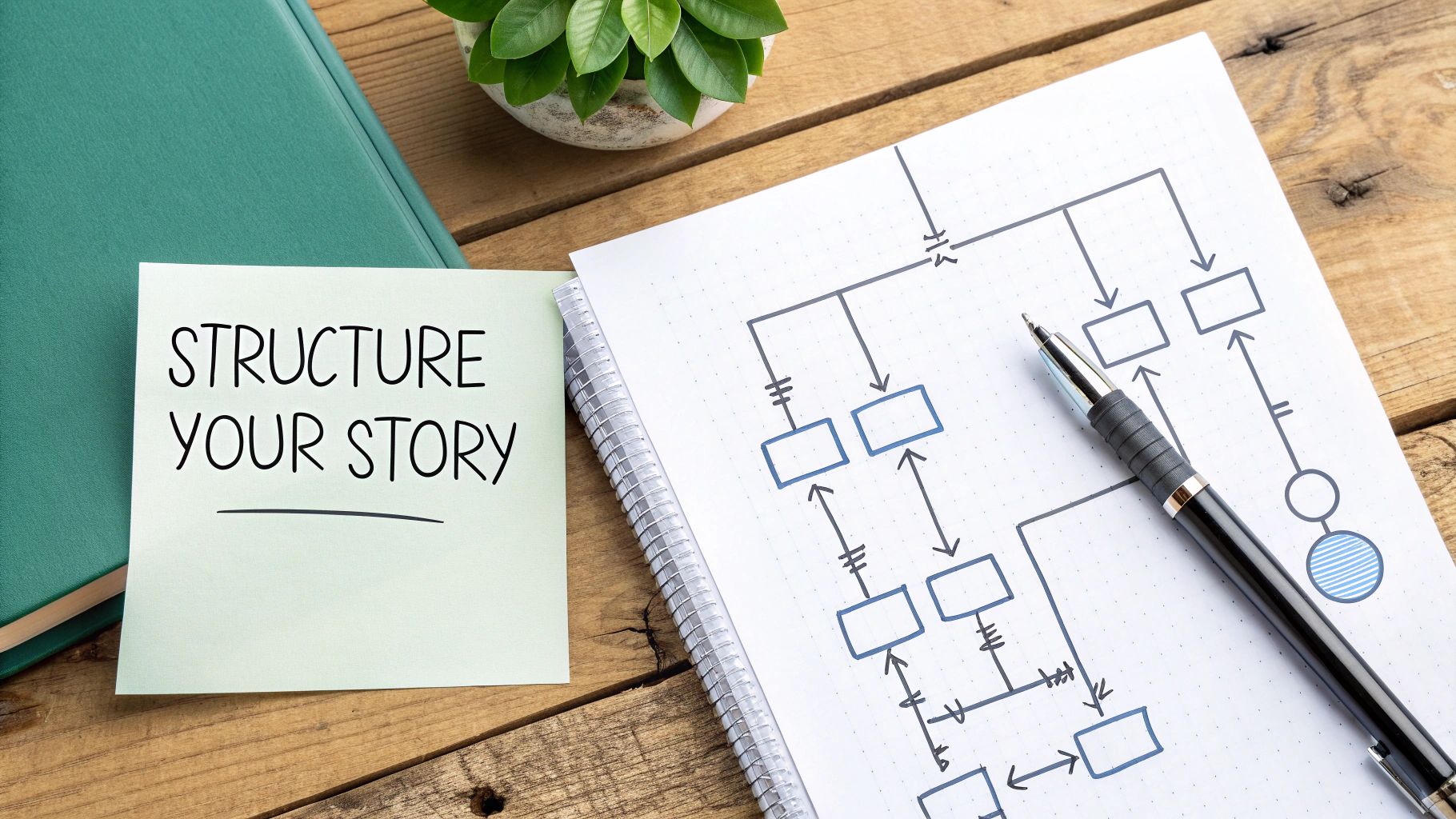
A powerful story is more than just a collection of events; it's a well-told journey. Once you’ve landed on your core theme, the next challenge is building a framework that guides the reader from your first sentence to your last. A solid structure is what separates a memorable essay from a random collection of memories. It ensures your message lands with real clarity and impact.
Think of yourself as an architect. You have your raw materials—your experiences, your insights, your "aha" moments. Now you need a blueprint. This plan gives your narrative a clear beginning, middle, and end, creating a cohesive story that shows not just what happened, but why it matters. A great first step is learning how to create a winning personal statement outline.
Crafting an Unforgettable Introduction
Your introduction is your one and only chance to make a first impression. Admissions officers read thousands of these things, and many of them start with the same tired phrases. Your goal is to make them sit up and pay attention from the very first line.
Please, avoid the clichés. "From a young age, I have always been passionate about..." or "I am applying to your program because..." are instant signs of a generic essay. They're predictable, and they completely hide your personality. A much better approach is to drop the reader right into the middle of a moment.
Try one of these hooks to get things started:
- Start with an anecdote: Drop the reader directly into a specific, vivid scene that means something to you.
- Pose a surprising question: Get them thinking or challenge a common assumption.
- Use a powerful statement: Kick things off with a concise, intriguing declaration that hints at your core theme.
For instance, instead of saying you love problem-solving, you could start with: "The entire robot collapsed three hours before the competition, and all I had was a roll of duct tape and a half-eaten bag of pretzels." Now that's an opening. It’s active, visual, and makes the reader desperate to know what happened next.
Building a Cohesive Narrative in the Body
The body of your essay is where you bring your story to life. Each paragraph should build on the one before it, guiding the reader through your journey of growth and discovery. This is not the place to simply list accomplishments from your resume. This is where you show your development through specific, well-chosen examples.
A fantastic framework for this is the "STAR" method, but with a crucial fifth element: Reflection.
- Situation: Briefly set the scene. Where were you? What was going on?
- Task: What was the challenge you faced or the goal you needed to achieve?
- Action: What specific steps did you take? Be the hero of your own story.
- Result: What happened? What was the outcome of what you did?
- Reflection: This is the most important part. What did you learn from it all? How did it change your perspective or shape who you are today?
This structure keeps your paragraphs focused and guarantees you’re always connecting your experiences back to your personal growth.
The body of your personal statement isn’t a report of events; it's the story of your evolution. Each paragraph should reveal a new layer of your character, motivation, or understanding, pushing the central narrative forward.
And don't forget to link your paragraphs with smooth transitions. Clear connections are vital for an essay that’s easy and enjoyable to read. For some extra help here, our guide on using transition words for essays offers plenty of examples to make your writing flow naturally.
Choosing Your Structural Approach
While telling your story chronologically is a classic for a reason, it’s not your only option. Depending on your core theme, a different structure might pack a bigger punch.
| Structure Type | Best For | Example |
|---|---|---|
| Chronological | Showing a clear progression of skills or interest over time. | Tracing your passion for medicine from a childhood science fair project to your current volunteer work at a local clinic. |
| Thematic | Connecting seemingly unrelated experiences under a single idea, like "problem-solving" or "communication." | Discussing how leading a debate team and coding a mobile app both taught you the power of clear, logical expression. |
| Narrative Arc | Focusing on a single, transformative experience with a clear beginning, a central challenge, and a final resolution. | Describing how organizing a failed community event taught you more about leadership than any success ever could. |
Pick the structure that best serves the story you want to tell. The goal is always to create a logical and compelling flow that highlights your best qualities.
Crafting a Conclusion That Resonates
Your conclusion is your final word. It's your last chance to leave a lasting impression, so make it count. A strong conclusion does more than just summarize what you've already said—it brings your story full circle by connecting your past, present, and future.
End your personal statement by looking forward. How do the lessons you've shared in your story connect to your goals at this specific institution? Why is this program the perfect next step on your journey?
Avoid just restating your introduction in different words. Instead, end with a powerful final thought, a compelling image, or a renewed sense of purpose that leaves the reader feeling confident in your potential. A great conclusion makes it clear that your story isn't over. It's just getting started.
Bringing Your Story to Life
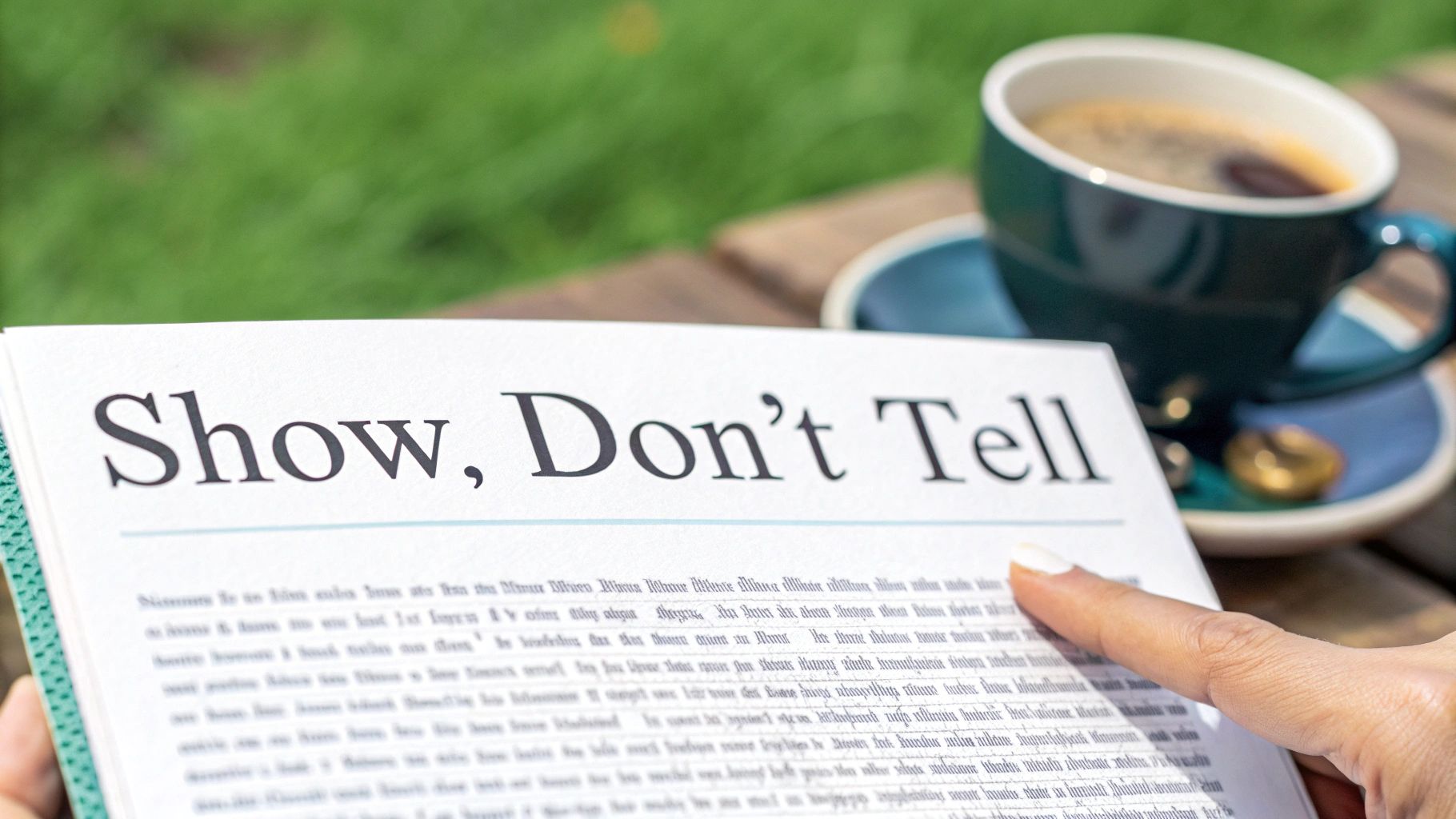
Facts and stats tell an admissions committee what you’ve done. A great story shows them who you are. This is your chance to move beyond a simple list of accomplishments and create a narrative that connects with the reader on a human level.
The goal isn't to sound like an academic paper; it's to sound like a real person. The most memorable personal statements capture the writer’s authentic voice. They find that sweet spot between professional and personal, making the reader feel like they're getting to know an individual, not just an applicant file.
Show, Don’t Tell
If you take only one piece of advice, let it be this: show, don't tell.
Telling the reader you're resilient is forgettable. Showing them a specific moment where you had to be resilient? That’s unforgettable.
Instead of just saying, "I am a determined problem-solver," paint a picture. Describe the feeling of staring at a broken piece of lab equipment hours before a deadline, the smell of burnt plastic hanging in the air, and the exact steps you took to MacGyver a solution. Vivid details like these engage the reader's senses and make your experiences feel real.
A great personal statement doesn't just list your qualities; it illustrates them through action. Let your experiences do the talking, and the reader will draw their own conclusions about who you are.
This technique is the heart of good writing. To really get a handle on it, check out our guide on 10 narrative writing techniques that can help you turn flat descriptions into compelling scenes.
Finding Your Authentic Voice
Your "voice" is simply the personality that comes through in your writing. Are you witty and analytical? Empathetic and reflective? There's no single "correct" voice, but whatever it is, it has to be yours—and it has to be consistent.
An essay that starts with a serious, academic tone and then suddenly switches to casual humor feels jarring and inauthentic. To find your natural style, try these simple exercises:
- Read it out loud. Does it sound like something you would actually say? If you find yourself stumbling over words or feeling like you’re playing a part, the voice isn't quite right.
- Tell a friend your story. Record yourself explaining the main point of your essay. The natural language and rhythm you use when speaking are your biggest clues.
- Just write. Spend 10 minutes writing about your topic without worrying about grammar or structure. This "freewriting" helps you tap into your genuine style before the self-editor kicks in.
Admissions officers read thousands of these things. They want to hear from you, not a sanitized, thesaurus-driven version of you.
Back Up Your Story with Cold, Hard Evidence
Storytelling creates an emotional connection, but concrete evidence provides the proof. This is absolutely critical in STEM, business, or any other field where data matters.
Vague claims like "I improved the process" are weak. Specific, quantified achievements are powerful.
For example, a data science applicant wouldn't just say they're skilled; they'd mention improving a model's efficiency by 25% or helping to increase user conversion rates by 15%. Numbers like these provide tangible proof of your impact. They turn claims into facts.
Think about your own experiences. Where can you add a number?
- Did you grow membership in a club? By what percentage?
- Did you streamline a task at your part-time job? How many hours did it save per week?
- Did you raise money for a cause? How much?
Even small numbers add a massive layer of credibility. This combination of heartfelt storytelling and hard evidence is what takes a personal statement from good to unforgettable.
Polishing Your Draft From Good to Great
Getting that first draft down is a massive win, but don’t celebrate just yet. It’s only the starting line. The real magic happens during revision, where you take a good story and make it unforgettable. This is where you sharpen your message, refine your voice, and make every single word count.
Think of editing less like a chore and more like the final, critical step in telling your story well. A polished essay tells the admissions committee you're a serious, detail-oriented candidate who respects their time. A few careless errors, on the other hand, can easily distract from an otherwise powerful narrative.
This final stage isn't just about catching typos. It’s about looking at your essay from every angle—from the big-picture flow down to the tiny details of comma placement. It's a multi-layered process that ensures your final submission is a clear, compelling reflection of your best self.
The Big-Picture Edit
Before you start hunting for grammar mistakes, step away from your essay for a day or two. Come back and read it with fresh eyes. The goal here is to check the overall structure, clarity, and emotional impact. Don't get bogged down in individual word choices yet.
Seriously, read your draft out loud. This is a non-negotiable step. The rhythm and flow of your writing—or lack thereof—become glaringly obvious when you hear them.
- Clarity and Focus: Is your main point crystal clear from start to finish? Can a stranger easily tell what the story is about and what you want them to take away from it?
- Narrative Flow: Does each paragraph build on the last one? Or are there jarring transitions where the story seems to leap from one idea to another without a clear connection?
- Pacing: Does the story move along at a good clip? Are there parts that drag or feel rushed?
- Voice: Does this actually sound like you? Or does it sound like you swallowed a thesaurus trying to impress someone?
After you read it through, ask yourself one simple question: "If an admissions officer only remembers one thing from my essay, what will it be?" If the answer isn't immediately obvious, you need to go back and strengthen your central theme.
Getting Effective Feedback
You’re too close to your own story to be an objective editor. You just are. Getting a second (or third) opinion is essential for spotting weaknesses you’ve completely overlooked. The key, however, is asking the right people for the right kind of feedback.
Don't just hand it over and ask, "Is this good?" That's way too broad. Give your readers specific instructions.
Ask a friend or family member who knows you well, "Does this sound like me?" Then, ask a teacher or counselor, "Is the writing clear and effective?" This way, you get feedback on both authenticity and quality.
Once the suggestions roll in, remember that you're the one in charge. You don't have to accept every single piece of advice. If a change makes the essay feel less like your story, it’s perfectly fine to stick with your original version. Trust your gut.
The Nitty-Gritty Proofread
Once you're happy with the big-picture stuff, it's time to zoom in on the sentence level. This is your final sweep for any technical errors that could chip away at your credibility. A great story can be totally undermined by sloppy mistakes.
This is the perfect moment to use a detailed guide to make sure you catch everything. For a complete rundown, our writing revision checklist walks you through this final polish step-by-step.
Here’s a quick list of what to look for:
- Grammar and Punctuation: Hunt down common culprits like subject-verb agreement issues, comma splices, and misplaced apostrophes.
- Spelling and Typos: Never rely solely on spell-check. It won't catch context errors like "your" vs. "you're" or "effect" vs. "affect."
- Word Choice: Can you swap any clichés or generic phrases for more precise, impactful language?
- Consistency: Make sure your formatting is consistent, especially with things like numbers and abbreviations.
Using tools for this step is smart, but it requires a human touch. AI-powered grammar checkers are great for spotting technical mistakes, but always review their suggestions critically. Never blindly accept a change that butchers your meaning or makes your writing sound robotic. The goal is to use technology to polish your authentic voice, not erase it.
Your Top Personal Statement Questions, Answered
Writing a personal statement brings up all sorts of weird, tricky questions. Even with a great outline, you’ll hit gray areas that can make you second-guess everything and grind your progress to a halt.
Let’s clear up some of the most common dilemmas so you can get back to writing with confidence.
How Personal Is Too Personal?
This is all about finding the right balance. You’re aiming for professional vulnerability. It’s incredibly powerful to share a personal struggle or a unique part of your story, but only if it serves a purpose. Does it reveal your resilience, your motivation, or the reason you're so committed to this path?
Don't share deeply sensitive details just for shock value. If it feels awkward to write or doesn't connect directly back to why you're a great fit for the program, leave it out.
The real test is relevance. Every personal detail has to earn its spot by strengthening your case.
Should I Use Humor?
Honestly, humor is a high-risk, high-reward move. Get it right, and your essay is memorable and shows off your personality. Get it wrong, and it can fall flat or, even worse, come across as unprofessional. Humor is just so subjective.
If you’re a genuinely witty person and the field you’re applying to has a more relaxed vibe, a single clever line might land well. But for most applicants, it’s much safer to build your essay on sincerity and passion. Don't force the jokes.
Can I Talk About a Bad Grade or a Failure?
Absolutely. But you have to frame it the right way. This isn’t a moment for excuses. It’s a chance to show maturity, self-awareness, and the ability to bounce back—all things admissions committees love to see.
The trick is to focus on what you learned from it.
- Briefly explain what happened, but don't dwell on it.
- Spend most of your time on the lesson you took away.
- Show how that experience made you a stronger, more prepared applicant today.
When you do that, you turn a potential red flag into a compelling story about growth.
How Do I Make My Introduction Stand Out?
Your opening line is the most valuable real estate in the entire essay. You have one chance to hook the reader and make them care. The fastest way to lose them is to start with a cliché they’ve already read a hundred times.
Please, avoid openers like, "From a young age, I have always been passionate about..." or "It has always been my dream to..."
Instead, drop your reader right into a moment. Start with a vivid scene, a surprising fact, or a question that cuts to the heart of your story. Your opening should be completely unique to you and hint at the essay's theme without giving it all away on the first line.
Ready to make sure your final draft sounds as authentic as you are? Natural Write can help you polish your AI-assisted drafts into compelling, humanized text that passes any detection tool. Perfect your personal statement at https://naturalwrite.com.
